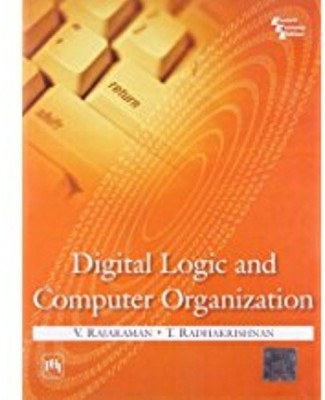Digital Logic and Computer Organization(English, Paperback, Rajaraman V.)
Quick Overview
Product Price Comparison
This introductory text on ŌĆśdigital logic and computer organizationŌĆÖ presents a logical treatment of all the fundamental concepts necessary to understand the organization and design of a computer. It is designed to cover the requirements of a first-course in computer organization for undergraduate Computer Science, Electronics, or MCA students. Beginning from first principles, the text guides students through to a stage where they are able to design and build a small computer with available IC chips. Starting with the foundation material on data representation, computer arithmetic and combinatorial and sequential circuit design, the text explains ALU design and includes a discussion on an ALU IC chip. It also discusses Algorithmic State Machine and its representation using a Hardware Description Language before shifting to computer organization. The evolutionary development of a small hypothetical computer is described illustrating hardware-software trade-off in computer organization. Its instruction set is designed giving reasons why each new instruction is introduced. This is followed by a description of the general features of a CPU, organization of main memory and I/O systems. The book concludes with a chapter describing the features of a real computer, namely the Intel Pentium. An appendix describes a number of laboratory experiments which can be put together by students, culminating in the design of a toy computer. Key Features ŌĆó Self-contained presentation of digital logic and computer organization with minimal pre-requisites ŌĆó Large number of examples provided throughout the book ŌĆó Each chapter begins with learning goals and ends with a summary to aid self-study by students. About The Author V. Rajaraman, Ph.D. (Wisconsin), F.A.Sc., FNA, FNAE, FCSI, is Honorary Professor, Supercomputer Education and Research Centre, Indian Institute of Science, Bangalore. Earlier (1963ŌĆō1982) he taught at the Indian Institute of Technology, Kanpur. A pioneer in computer science education and research in India, Prof. Rajaraman was awarded the Shanti Swarup Bhatnagar Award, the Homi Bhabha Award for Research in Applied Sciences, the U.P. Government National Award for Excellence in Teaching and Research, the Syed Hussain Zaheer Medal by the Indian National Science Academy and lifetime contribution award in engineering by the Indian National Academy of Engineering. A recipient of the Padma Bhushan, he has published many research papers in reputed national and international journals besides authoring several established books. T. Radhakrishnan, Ph.D., is Professor of Computer Science and Software Engineering in the Faculty of Engineering, Concordia University in Montreal. He graduated from Guindy Engineering College and obtained his Ph.D. from IIT Kanpur. After teaching at IIT Kanpur and IIT Madras for a few years, he joined Concordia University in Montreal in 1974. His research interests include Agent technology, Human Computer Interfaces, and Medical Informatics. He holds several patents, publishes regularly, and has supervised over seventy graduate students in the last thirty years. He has contributed several times to curriculum design and development in three countries, India, Canada, and Mexico. Besides authoring textbooks, he enjoys writing in Tamil about technology and other socially relevant topics. Table of Contents Preface. 1. Data Representation. 2. Boolean Algebra and Logic Gates. 3. Combinatorial Switching Circuits. 4. Sequential Switching Circuits. 5. Arithmetic and Logic Unit. 6. Application of Sequential Circuits. 7. Computer SystemsŌĆöMultiple Views. 8. Basic Computer Organization. 9. Central Processing Unit. 10. Memory Organization. 11. Input-output Devices. 12. Input-Output Organization. 13. Case Study of a Real Computer System. Appendix A. Suggested Hardware Lab Experiments. B. Decision Table Terminology. References. Index.


